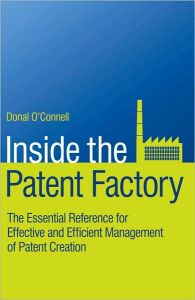Join getAbstract to access the summary!

Join getAbstract to access the summary!
Donal O'Connell
Inside the Patent Factory
The Essential Reference for Effective and Efficient Management of Patent Creation
Wiley, 2008
What's inside?
Innovation is so important these days that your organization needs not only a factory but also a Patent Creation Factory.
Recommendation
Donal O’Connell’s book is for those interested in developing a system for patenting products to protect their intellectual property rights (IPR). Rather than treating each patent as a new creation, O’Connell suggests that you lay out your tools and procedures to make the most of your talent – just as you would for manufacturing your products. The book is U.K.-centric, but it usefully analyzes the differences in patent law between Europe, the United States and Asia. O’Connell frankly insists that patents are not the universal answer for protecting intellectual property. Instituting a “Patent Creation Factory” for just one or two patents, he explains, is not sensible. However, if your firm depends on continuous product innovation, getAbstract says this awkwardly written but useful guide is for you. O’Connell outlines an efficient process for creating new products, tracking their path through the patenting process and protecting your patents once you receive them.
Summary
About the Author
Donal O’Connell is Director of IPR at Nokia and has deep experience in global wireless telecommunications.//

















Comment on this summary
that is the question.